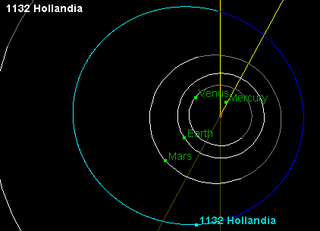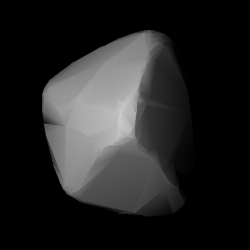Related Research Articles
456 Abnoba, provisional designation 1900 FH, is a stony background asteroid from the central regions of the asteroid belt, approximately 40 kilometers in diameter. It was discovered on 4 June 1900, by astronomers Max Wolf and Arnold Schwassmann at the Heidelberg-Königstuhl State Observatory in southwest Germany. The asteroid was named after the Celtic deity Abnoba.
1027 Aesculapia, provisional designation A923 YO11, is a Themistian asteroid from the outer region of the asteroid belt, approximately 33 kilometers in diameter.
1044 Teutonia, provisional designation 1924 RO, is a stony asteroid from the central regions of the asteroid belt, approximately 16 kilometers in diameter. It was discovered on 10 May 1924, by astronomer Karl Reinmuth at Heidelberg Observatory in southwest Germany. The asteroid was named after the land inhabited by the Teutonic people.

1129 Neujmina is an Eos asteroid from the outer regions of the asteroid belt. It was discovered on 8 August 1929, by astronomer Praskoviya Parchomenko at the Simeiz Observatory on the Crimean peninsula. The stony S-type asteroid has a rotation period of 5.1 hours and measures approximately 34 kilometers in diameter. It was named after Soviet astronomer Grigory Neujmin.

1132 Hollandia, provisional designation 1929 RB1, is a stony asteroid from the middle region of the asteroid belt, approximately 27 kilometers in diameter. It was discovered on 13 September 1929, by Dutch astronomer Hendrik van Gent at Leiden Southern Station, annex to the Johannesburg Observatory in South Africa. It was named for the region Holland in the Netherlands.
1166 Sakuntala, provisional designation 1930 MA, is a stony background asteroid from the central regions of the asteroid belt, approximately 26 kilometers in diameter. Discovered by Praskovjya Parchomenko at Simeiz Observatory in 1930, the asteroid was named after the figure of Shakuntala from an ancient Indian drama.
1194 Aletta, provisional designation 1931 JG, is a carbonaceous asteroid from the outer region of the asteroid belt, approximately 55 kilometers in diameter. It was discovered on 13 May 1931, by South African astronomer Cyril Jackson at Johannesburg Observatory in South Africa. It was later named after the discoverer's wife Aletta Jackson.
3037 Alku, provisional designation 1944 BA, is a carbonaceous asteroid from the central region of the asteroid belt, approximately 20 kilometers in diameter. It was discovered on 17 January 1944, by Finnish astronomer Yrjö Väisälä at Turku Observatory in Southwest Finland.
1304 Arosa, provisional designation 1928 KC, is a metallic asteroid from the outer region of the asteroid belt, approximately 40 kilometers in diameter. It was discovered on 21 May 1928, by German astronomer Karl Reinmuth at Heidelberg Observatory in southwest Germany. It was named after the Swiss mountain village of Arosa.
3915 Fukushima, provisional designation 1988 PA1, is a carbonaceous asteroid from the inner regions of the asteroid belt, approximately 21 kilometers in diameter.
1177 Gonnessia, provisional designation 1930 WA, is a dark background asteroid from the outer regions of the asteroid belt, approximately 99 kilometers in diameter. It was discovered on 24 November 1930, by French astronomer Louis Boyer at the Algiers Observatory in Algeria, North Africa, and named after astronomer François Gonnessiat.
1384 Kniertje, provisional designation 1934 RX, is a dark Adeonian asteroid from the central regions of the asteroid belt, approximately 26 kilometers in diameter. It was discovered on 9 September 1934, by Dutch astronomer Hendrik van Gent at the Union Observatory in Johannesburg, South Africa. The asteroid was named after a character in the Dutch play Op Hoop van Zegen by Herman Heijermans.
1284 Latvia, provisional designation 1933 OP, is a rare-type asteroid from the middle region of the asteroid belt, approximately 37 kilometers in diameter. It was discovered on 27 July 1933, by German astronomer Karl Reinmuth at Heidelberg Observatory in southern Germany, and named after the Republic of Latvia.
1264 Letaba, provisional designation 1933 HG, is a carbonaceous asteroid and possible tumbler from the background population of the outer asteroid belt, approximately 70 kilometers in diameter. It was discovered on 21 April 1933, by South African astronomer Cyril Jackson at the Union Observatory in Johannesburg. The asteroid was named for the Letaba River in eastern South Africa.
1176 Lucidor, provisional designation 1930 VE, is a carbonaceous background asteroid from the central region of the asteroid belt, approximately 30 kilometers in diameter. It was discovered by Eugène Delporte in 1930, who named it after a friend.
1318 Nerina, provisional designation 1934 FG, is a Phocaea asteroid from the inner regions of the asteroid belt, approximately 13 kilometers in diameter. It was discovered on 24 March 1934, by South African astronomer Cyril Jackson at the Union Observatory in Johannesburg. The possibly metallic X-type asteroid has a notably short rotation period of 2.5 hours. It was named for the flowering plant Nerine, also known as "Guernsey lily" or "Jersey lily".
1330 Spiridonia, provisional designation 1925 DB, is a dark background asteroid of primitive composition, located in the outer regions of the asteroid belt, approximately 65 kilometers in diameter. It was discovered on 17 February 1925, by Soviet astronomer Vladimir Albitsky at the Simeiz Observatory on the Crimean peninsula. The asteroid was named after the discoverer's brother-in-law, Spiridon Zaslavskij.
1266 Tone is a dark background asteroid from the outer regions of the asteroid belt, approximately 80 kilometers in diameter. Discovered by astronomer Okuro Oikawa at the Tokyo Observatory in 1927, it was assigned the provisional designation 1927 BD. The asteroid was later named after the Tone River, one of Japan's largest rivers.

2120 Tyumenia is a dark background asteroid, approximately 45 kilometers in diameter, located in the outer regions of the asteroid belt. It was discovered on 9 September 1967, by Soviet astronomer Tamara Smirnova at the Crimean Astrophysical Observatory in Nauchnyj, on the Crimean peninsula. The asteroid was named for the now Russian district of Tyumen Oblast in Western Siberia.
1708 Pólit, provisional designation 1929 XA, is a very dark asteroid from the outer region of the asteroid belt, approximately 29 kilometers in diameter. It was discovered on 30 November 1929, by Spanish astronomer of Catalan origin Josep Comas i Solà at the Fabra Observatory in Barcelona, and was later named after Catalan astronomer Isidre Pòlit i Boixareu.
References
- 1 2 3 4 5 6 "JPL Small-Body Database Browser: 1084 Tamariwa (1926 CC)" (2017-11-02 last obs.). Jet Propulsion Laboratory . Retrieved 9 November 2017.
- 1 2 3 Schmadel, Lutz D. (2007). "(1084) Tamariwa". Dictionary of Minor Planet Names – (1084) Tamariwa. Springer Berlin Heidelberg. p. 92. doi:10.1007/978-3-540-29925-7_1085. ISBN 978-3-540-00238-3.
- 1 2 3 4 5 6 7 8 9 "LCDB Data for (1084) Tamariwa". Asteroid Lightcurve Database (LCDB). Retrieved 9 November 2017.
- 1 2 "Asteroid 1084 Tamariwa – Proper Elements". AstDyS-2, Asteroids – Dynamic Site. Retrieved 28 October 2019.
- 1 2 3 4 Nugent, C. R.; Mainzer, A.; Bauer, J.; Cutri, R. M.; Kramer, E. A.; Grav, T.; et al. (September 2016). "NEOWISE Reactivation Mission Year Two: Asteroid Diameters and Albedos". The Astronomical Journal. 152 (3): 12. arXiv: 1606.08923 . Bibcode:2016AJ....152...63N. doi: 10.3847/0004-6256/152/3/63 .
- 1 2 3 Masiero, Joseph R.; Grav, T.; Mainzer, A. K.; Nugent, C. R.; Bauer, J. M.; Stevenson, R.; et al. (August 2014). "Main-belt Asteroids with WISE/NEOWISE: Near-infrared Albedos". The Astrophysical Journal. 791 (2): 11. arXiv: 1406.6645 . Bibcode:2014ApJ...791..121M. doi:10.1088/0004-637X/791/2/121. S2CID 119293330 . Retrieved 9 November 2017.
- 1 2 3 4 Tedesco, E. F.; Noah, P. V.; Noah, M.; Price, S. D. (October 2004). "IRAS Minor Planet Survey V6.0". NASA Planetary Data System. 12: IRAS-A-FPA-3-RDR-IMPS-V6.0. Bibcode:2004PDSS...12.....T . Retrieved 22 October 2019.
- 1 2 3 4 Usui, Fumihiko; Kuroda, Daisuke; Müller, Thomas G.; Hasegawa, Sunao; Ishiguro, Masateru; Ootsubo, Takafumi; et al. (October 2011). "Asteroid Catalog Using Akari: AKARI/IRC Mid-Infrared Asteroid Survey". Publications of the Astronomical Society of Japan. 63 (5): 1117–1138. Bibcode:2011PASJ...63.1117U. doi:10.1093/pasj/63.5.1117. (online, AcuA catalog p. 153)
- 1 2 3 4 Mainzer, A.; Grav, T.; Masiero, J.; Hand, E.; Bauer, J.; Tholen, D.; et al. (November 2011). "NEOWISE Studies of Spectrophotometrically Classified Asteroids: Preliminary Results". The Astrophysical Journal. 741 (2): 25. arXiv: 1109.6407 . Bibcode:2011ApJ...741...90M. doi:10.1088/0004-637X/741/2/90. S2CID 35447010.
- 1 2 DeGraff, David R. (October 2017). "Stull Observatory Lightcurve Observations: 1998-2002". The Minor Planet Bulletin. 44 (4): 350–354. Bibcode:2017MPBu...44..350D. ISSN 1052-8091 . Retrieved 9 November 2017.
- 1 2 Degraff, D. R.; Robbins, A. M.; Gutermuth, R. A. (December 1998). "Rotation Curves for 13 Asteroids". American Astronomical Society. 30: 1390. Bibcode:1998AAS...193.9608D . Retrieved 9 November 2017.
- 1 2 Ivarsen, Kevin; Willis, Sarah; Ingleby, Laura; Matthews, Dan; Simet, Melanie (June 2004). "CCD observations and period determination of fifteen minor planets". The Minor Planet Bulletin. 31 (2): 29–33. Bibcode:2004MPBu...31...29I. ISSN 1052-8091 . Retrieved 9 November 2017.
- 1 2 Sada, Pedro V. (June 2008). "Lightcurve Analysis of 1084 Tamariwa". The Minor Planet Bulletin. 35 (2): 50. Bibcode:2008MPBu...35...50S. ISSN 1052-8091 . Retrieved 9 November 2017.
- 1 2 Klinglesmith, Daniel A., III (January 2017). "Asteroid Photometry Results from Etscorn Observatory". The Minor Planet Bulletin. 44 (1): 69–72. Bibcode:2017MPBu...44...69K. ISSN 1052-8091 . Retrieved 9 November 2017.
{{cite journal}}: CS1 maint: numeric names: authors list (link) - 1 2 Sada, Pedro V.; Navarro-Meza, Samuel; Reyes-Ruiz, Mauricio; Olguin, Lorenzo L.; Saucedo, Julio C.; Loera-Gonzalez, Pablo (April 2016). "Results of the 2015 Mexican Asteroid Photometry Campaign". The Minor Planet Bulletin. 43 (2): 154–156. Bibcode:2016MPBu...43..154S. ISSN 1052-8091 . Retrieved 9 November 2017.
- 1 2 3 Behrend, Raoul. "Asteroids and comets rotation curves – (1084) Tamariwa". Geneva Observatory. Retrieved 9 November 2017.
- 1 2 Stecher, George; Ford, Lyle; Lorenzen, Kayla; Ulrich, Sarah (June 2008). "Photometric Measurements of 1084 Tamariwa at Hobbs Observatory". The Minor Planet Bulletin. 35 (2): 76–77. Bibcode:2008MPBu...35...76S. ISSN 1052-8091 . Retrieved 9 November 2017.
- 1 2 3 Binzel, R. P. (October 1987). "A photoelectric survey of 130 asteroids". Icarus. 72 (1): 135–208. Bibcode:1987Icar...72..135B. doi:10.1016/0019-1035(87)90125-4. ISSN 0019-1035 . Retrieved 9 November 2017.
- 1 2 "1084 Tamariwa (1926 CC)". Minor Planet Center. Retrieved 9 November 2017.